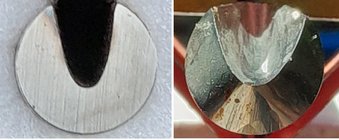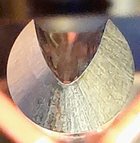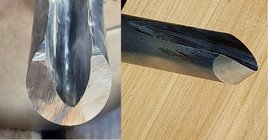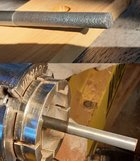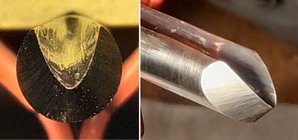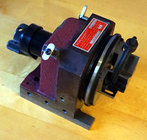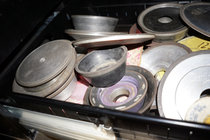Not many of us have the necessary expertise or the heat treatment setup to make our own bowl gouges from annealed HSS bar stock, but most of us would have or could readily obtain the necessary means for making our own bowl gouges from ready to use bar stock.
Why DIY?
There is an example of how forum member Hughie has done this, which has been recently posted over in Tutorials and Tips…
 www.aawforum.org
www.aawforum.org
I also collaborated on that project and, as you will see, I did some flute customisation to optimise that for what we were doing there.
Of course you can’t add metal back into a flute, but you can re-grind it to a different profile if there is sufficient metal to do so. In that post over in Tutorials and Tips I have a before and after images where I have reground the flute profile. For reference, here are the before and after images…
With a DIY bowl gouge you can endlessly customise the flute to suit yourself… :~}
Even if you didn’t make the gouge yourself this is something you can do on many bowl gouges. It strikes me that some woodturners will play around endlessly with different bevel grinds, but treat the flutes on their bowl gouges as sacrosanct. If you are not using a gouge very much, or at all, it might be a candidate for some customisation. You don’t need to regrind the full length of the flute, just the first inch or so will probably do.
If you are thinking about alternatives to the flute profile you currently have on a bowl gouge, my thread on flutes profiles and their descriptors has a repository of the most commonly used ones that might be helpful there…
 www.aawforum.org
www.aawforum.org
Hughie explains in his Tantung post how he uses a thin cutoff wheel to establish the general flute profile followed by his other grinding methods. I used various sized burs (diamond or CBN) in my Dremel to change the flute profile on the above example followed by an abrasive cutting compound to finesse and polish the flute profile.
If you have a bowl gouge with a flute that is almost all ground away there will be nothing lost by having a go at extending the flute with this method or maybe trying a variation on the original flute profile!
Making your own bowl gouge from scratch
Most of the gouges that we could purchase years ago needed a lot of flute grinding and polishing to remove the grinding tracks to get a good edge. So, I have always done some of that and a bit of flute profile ‘adjustment’ while I’ve been at it, but never got to make a bowl gouge starting with the bar stock.
Inspired by our forum colleague, hughie, I have been recently experimenting with making my own bowl gouges from bar stock. I already had several pieces of bar stock to experiment on. These were fully heat treated and ready to use and not just annealed as that would require skills and heat treatment equipment that are well beyond me.
I started with a piece of ‘ready to use’ V10 bar stock into which I ground a customised flute…
Other round bar stock may be more readily obtainable than V10, and even if M2 HSS is not your preferred steel, it is relatively cheap and a good starting point for your experimentation.
However, there is likely to be some of your preferred steels in your tool rack already … I’m referring here to the handleless bowl gouges that come with a good piece of HSS at the non-flute end waiting to have another flute added to that end. See the following thread for a discussion on some of the gouges that come with shafts that are fully heat treated for their entire lengths and not just their flute end.…
https://www.aawforum.org/community/threads/gouge-heat-treatment.20862/
Of course, you can buy gouges that already have a flute at both ends with different grinds on each end. You just reverse the gouge in your removable handle to use either end, but why not do the same with one of your current gouges and perhaps while you are at it also give the other end a different flute profile that you would like to experiment with. I did this with two of my gouges; one in V10 and the other in M42 steel.
Following is a M42 bowl gouge that came with a V flute to which I added a parabolic flute to the other end. The existing V flute on this gouge works well with the higher bevel angles from 55° and up, but gets beaky with my grind on the lower nose bevel angles, like 40°. Here is the parabolic flute that I have ground into the tang end and the 42° bevel I added to that…
I did the same on the tang end of a V10 bowl gouge. … for that see my next post.
Why DIY?
- a more affordable way to experiment with different flute profiles,
- a lower entry point to try out different cutting 'steels’,
- more options in your tool rack for less cost.
There is an example of how forum member Hughie has done this, which has been recently posted over in Tutorials and Tips…
Tantung gouge tips
Some years ago I came across Tantung steel which according to the blurb is in between HSS and TCT and can be ground by conventional grind stones. Then I ran across a comment by Robbo Hippy about its edge holding ability, something along the lines of “sharpen it in the morning and all turn all...
I also collaborated on that project and, as you will see, I did some flute customisation to optimise that for what we were doing there.
Of course you can’t add metal back into a flute, but you can re-grind it to a different profile if there is sufficient metal to do so. In that post over in Tutorials and Tips I have a before and after images where I have reground the flute profile. For reference, here are the before and after images…
With a DIY bowl gouge you can endlessly customise the flute to suit yourself… :~}
Even if you didn’t make the gouge yourself this is something you can do on many bowl gouges. It strikes me that some woodturners will play around endlessly with different bevel grinds, but treat the flutes on their bowl gouges as sacrosanct. If you are not using a gouge very much, or at all, it might be a candidate for some customisation. You don’t need to regrind the full length of the flute, just the first inch or so will probably do.
If you are thinking about alternatives to the flute profile you currently have on a bowl gouge, my thread on flutes profiles and their descriptors has a repository of the most commonly used ones that might be helpful there…
Bowl Gouge Flute Descriptors
Bowl Gouge Flute Descriptors - Part 1 of 8 Warning: Long multi-post starter to this thread… and some folk may prefer to be spending their time out in their workshop turning wood than engaging in pedantic stuff about flute profiles and names… :~} I have become concerned about the sloppy and...
Hughie explains in his Tantung post how he uses a thin cutoff wheel to establish the general flute profile followed by his other grinding methods. I used various sized burs (diamond or CBN) in my Dremel to change the flute profile on the above example followed by an abrasive cutting compound to finesse and polish the flute profile.
If you have a bowl gouge with a flute that is almost all ground away there will be nothing lost by having a go at extending the flute with this method or maybe trying a variation on the original flute profile!
Making your own bowl gouge from scratch
Most of the gouges that we could purchase years ago needed a lot of flute grinding and polishing to remove the grinding tracks to get a good edge. So, I have always done some of that and a bit of flute profile ‘adjustment’ while I’ve been at it, but never got to make a bowl gouge starting with the bar stock.
Inspired by our forum colleague, hughie, I have been recently experimenting with making my own bowl gouges from bar stock. I already had several pieces of bar stock to experiment on. These were fully heat treated and ready to use and not just annealed as that would require skills and heat treatment equipment that are well beyond me.
I started with a piece of ‘ready to use’ V10 bar stock into which I ground a customised flute…
Other round bar stock may be more readily obtainable than V10, and even if M2 HSS is not your preferred steel, it is relatively cheap and a good starting point for your experimentation.
However, there is likely to be some of your preferred steels in your tool rack already … I’m referring here to the handleless bowl gouges that come with a good piece of HSS at the non-flute end waiting to have another flute added to that end. See the following thread for a discussion on some of the gouges that come with shafts that are fully heat treated for their entire lengths and not just their flute end.…
https://www.aawforum.org/community/threads/gouge-heat-treatment.20862/
Of course, you can buy gouges that already have a flute at both ends with different grinds on each end. You just reverse the gouge in your removable handle to use either end, but why not do the same with one of your current gouges and perhaps while you are at it also give the other end a different flute profile that you would like to experiment with. I did this with two of my gouges; one in V10 and the other in M42 steel.
Following is a M42 bowl gouge that came with a V flute to which I added a parabolic flute to the other end. The existing V flute on this gouge works well with the higher bevel angles from 55° and up, but gets beaky with my grind on the lower nose bevel angles, like 40°. Here is the parabolic flute that I have ground into the tang end and the 42° bevel I added to that…
I did the same on the tang end of a V10 bowl gouge. … for that see my next post.

